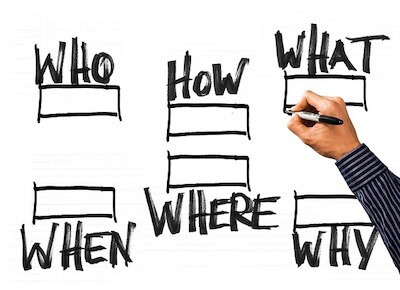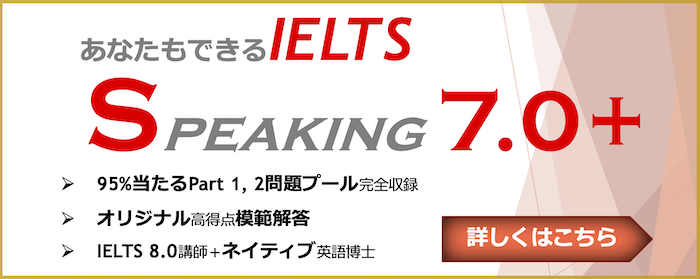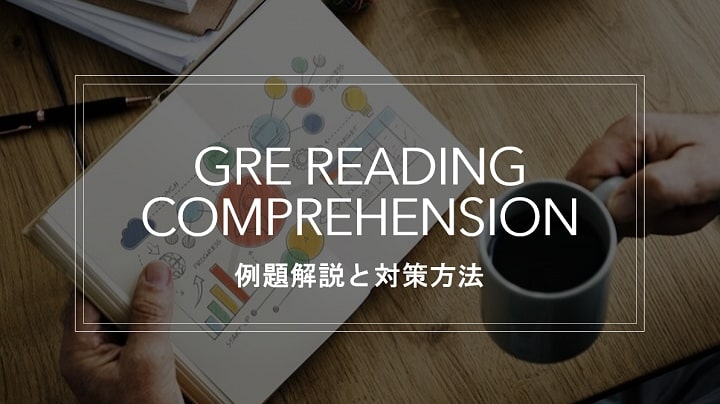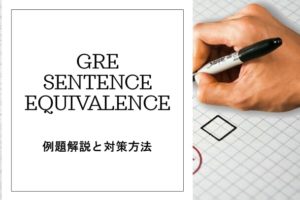TOEFL102・GRE320。純ドメから夢の海外留学を達成。現在はNYUで数理ファイナンスを勉強中。
目次
RCをGRE Verbalの得点源にすべき4つの理由
RCは、以前の記事でも述べましたが、Verbalの中で一番得点源とするべきセクションです。理由は以下のとおりです。
- 出題トピックが(TOEFL以上に)偏っており、問題文の形式に慣れやすい
- 問題の回答となる選択肢が限られている
- 単語の意味や細部が分からなくても要旨が分かれば正解できる問題がある
- Verbalの約半分はRC(スコアの50%を占める)
それでは、早速RCの解き方を解説していきます。
RCの全体的な戦略、読み方

RCに慣れるため、まずは以下のパッセージを見てみましょう。
Example Short Passage: Insect Behavior
Insect behavior generally appears to be explicable in terms of unconscious, inflexible stimulus—response mechanisms. For instance, a female sphex wasp leaves her egg sealed in a burrow alongside a paralyzed grasshopper, which her larvae can eat upon hatching. Before she deposits the grasshopper in the burrow, she inspects the burrow; if the inspection reveals no problems, she drags the grasshopper inside by its antennae. As thoughtful as this behavior appears, it reveals its mechanistic character upon interference. Darwin discovered that prior removal of the grasshopper’s antennae prevents the wasp from depositing the grasshopper, even though the legs or ovipositor could also serve as handles. Likewise, Fabre moved the grasshopper a few centimeters away from the burrow’s mouth while the wasp was inside inspecting. The wasp returned the grasshopper to the edge of the burrow and then began a new inspection. Fabre performed this disruptive maneuver forty times; the wasp’s response never changed.
(出典:Manhattan Prep)
TOEFLのReadingに比べると単語が難しいかもしれませんが、要旨を理解することを意識してください。以下にお勧めできるいくつかの戦略を記載します。
俯瞰・精読の使い分け
まず心構えですが、時間が足りないからと言って急ぐのをやめましょう。精神的に余裕がなくなると、文章のほとんどを読み飛ばして、結局パッセージの核心を理解しないまま質問文を読むことになります。
するとパッセージを読み直すことになり、ますます時間が足りなくなってしまいます。一方、すべての文章を精読するとのも時間が足りないですので、俯瞰・精読の使い分けが必要になります。
つまり①各段落の最初の文をはゆっくり読み(精読)、②残りの文は概要をつかむように(俯瞰)します。
様々なパッセージで練習して、この読み方の使い分けができるようになると良いかと思います。ですが、最初のうちはおそらく時間が足りないと思いますので、その場合は潔くランダムクリックで問題を飛ばしましょう。
ただし、その場合でも、パッセージをなるべく読み直さずに質問に答える癖をつけると良いと思います。
メモの取り方
では何も見ないで質問に答えるのかという話になりますが、時間がもったいないと思う方もいるかもしれませんが、いくつかの参考書に書かれているように、個人的には簡単なメモを取りつつパッセージを読むことを勧めます。
上記のパッセージであれば、例えば以下のようなメモです。
- Insect behav. = unconsc. stim/resp. = inflexible
- — Ex: wasp
- D: w. won’t drag g. w/o ant.
- F: endless cycle
- (w = wasp, g = grasshopper, D = Darwin, F = Fabre)
ポイントはあまり細部に集中しないことです。もちろん、細部が質問で問われることもあるのですが、ほとんどの場合は単純に該当するセンテンスを抜粋できれば正解できます。
センテンスを素早く見つけるためにも、このようなメモを残してパッセージの全体像を把握することが大事です。
もちろん、この程度あれば頭の中で整理できるという方もいるかもしれませんが、私の経験上、パッセージを読んだときは理解したつもりでも、質問に答える段階で結局パッセージ読み直すということが良く起こっていたので、基本的には簡単なメモを取ることをお勧めします。
また、パッセージを積極的に言い換え、なるべく簡単な単語にすることも勧めます。自分でメモを取ることによりアクティブリーディングができます。
つまり「今まで読んだことのある他の文章とどのように関係しているのか?」といったことを考えながら自然と読める癖がつきます。
これは重要な作業で、RC文章でよく見られる複雑な文は、文を全体像とリンクさせて中心的な概念を理解しようとすると、理解しやすくなります。
文章を読むときはいつでも、頭の中でいくつか質問をすることでそれを実現できます。例えば以下のような質問です。
- これは新しい文章なのか、それとも新しい情報がないものなのか。
- この文は予想されるものか、あるいは驚くべきものか。
- 以前の主張や証拠を支持または反対するものか。
- 答えたり質問したりするべきことか。
- 証拠なのか、それとも単なる仮説なのか。
- 判断なのか、それとも単なる信念なのか。
- 中心的なアイデアの原因か結果か。
- パッセージの今までの流れを変えるか。
問題の解き方
次に、問題を読みながらパッセージを読んでいくことはお勧めしません。つまり、問題①を読む→パッセージを読んで解答を見つける→問題②を読む→パッセージを読んで解答を見つける→……といった方法です。
TOEFLであれば多くの方と同様、私もこのように解きますが、RCではパッセージの概要をつかむことがはるかに重要です。
RCを解いたことがあるかたであれば、最初の質問が ”What is the main idea/purpose of the passage?” となっている問題を見たことがあるかもしれませんが、このようにGREではいきなりパッセージの概要を聞かれます。
冒頭の段落がただのイントロで、最後の段落に著者の主張が書かれていることもありますので、パッセージを最後まで読んでから質問に目を通すことをお勧めします。
ただし、通常の速度で読むと時間が足りないと思われますので、各段落の最初の文をゆっくり読み、残りの文は概要をつかむようにします。
例えば、先ほどのパッセージであれば、DarwinとFabreについての文は、彼らが何か具体的な例を見つけた、ということが分かれば十分です。TOEFLでもこのようなパッセージの読み方をされている方は、GREでも同じ戦略が通用します。
これらの最初の2、3の文は、文章全体に重要な文脈を与えます。最初にこれらの文章を理解しないと、段落全体の要旨を理解することができなくなり、その結果、段落に記載されている情報に基づいて質問に答えることができなくなります。
ほとんどのRCは複雑で長く、不透明な文で始まります(先の例であれば、Insect behavior generally appears to be explicable in terms of unconscious, inflexible stimulus—response mechanisms)が、その後に例が続く場合が多いですので、最初の2、3の文を読むことをお勧めします。
パッセージの5つの要素

解き方の概要が分かったところで、具体的なRCのパッセージの構成を見ていきましょう。
アイデア
- アイデアは、パッセージの主題であり、これを理解することがパッセージの理解、また質問への解答に必須となってきます。残りの4つの要素は全てアイデアを補完するものです。
ストーリー
- ストーリーは、アイデアを理解するために必要な重要な情報で、状況・背景などです。トピックに関する文脈や、基本的な事実はストーリーとして与えられます。
エビデンス
- エビデンスは、アイデアを裏付けるために著者が収集または提供するものです。エビデンスには、アイデアを主張する引用、事実、調査、意見など含まれます。エビデンスは時々は反対の議論への譲歩を含むかもしれません。これは、パッセージの種類、およびトピックに関する著者の姿勢によって異なります。エビデンスは作者の考えを変えることができるパッセージの重要な部分なので、パッセージのかなりの部分を占めることもあります。
結果
- 結果は、アイデアの適用のために起こる最終結果です。しばしばパッセージの終わりに見られます。常に存在するわけではありませんが、存在するときはいつでも重要になる傾向があります。
トーン
- トーンは、問題の主題またはトピックに対する著者の感情の説明に他なりません。トーンはポジティブ、ネガティブ、またはニュートラルに大別できます。また、パッセージ内のいくつかのキーワードにより、トーンを推測できます。
一見当たり前かもしれませんが、英語と日本語の文構造は全く違うということを強調しすぎることはありません。TOEFLでR28-30が取れていれば既にご存知の内容かもしれませんが、改めて確認してください。
特に後で解説しますが、トーンを問う問題(Which of the following best describes the tone of the passage?など)についてはTOEFLでは見られず、GRE独特のものです。
8つの質問別対策

主題・目的の質問
[例]
- What is the main idea/purpose of the passage?
- The primary focus of this passage is on which of the following?
- In the passage, the author is primarily interested in…
- The primary purpose of this passage is to…
主題・目的の質問は、最も頻繁に見受けられる質問タイプです。主題はパッセージ全体に関連しているため、どの段落にも明確に要約されていないこともあります。
しかし大体の場合、主題が最初の段落に述べられています。この質問に対する正しい答えは、パッセージの範囲を超えることはなく、パッセージ全体に基づくものです。
パッセージの一部に限定されている、パッセージの「外側」に出ている関係ないもの、またはパッセージの内容を超えるような選択肢は排除できます。
ステップ1:最初の段落全体をスキャン
ほとんどの場合、主題は直接的または間接的に、最初の段落自体に記載されています。最初の段落をスキャンして、主なアイデアを探すようにしてください。
特定の文章が主な考えであるかどうかを暗示するシグナルワードはありませんが、作者の言語を調べることでこれを容易に推測できます。
ステップ2:最後の段落全体をスキャン
いくつかのケースでは、主題が、著者の意見に明確な結論を与えるところ、つまりパッセージの終わりに述べられています。
この最終的な意見は著者が何について話しているかという考えを与え、そして本質的に全体の主題を与えます。
ステップ3:回答選択肢のキーワードを分析する
答えの選択肢の中のキーワード(通常は文の最初の単語)を分析します。比較、評価、説明など、著者の意図は何かを自問してください。回答選択のキーワードをテキストのキーワードと一致させます。
また、パッセージに記載されていない、主題の詳細として何かを追加するような回答の選択肢、1つの段落だけにフォーカスしている選択肢を除外します。
[例題]
Nothing shows up the schizophrenia of the Indian mind in the face of this challenge than that the two principal leaders of the national struggle for independence Mahatma Gandhi and Mr. Nehru should have come to contrary conclusions. The Mahatma was for an outright rejection of the western civilization, which is often described as Satanic. Mr. Nehru was for all-out industrialization. Both spoke from utter conviction and were extremely articulate in stating their positions. But neither of them thought it worth his while to grapple with the troublesome details when it came to making the reality conform to the vision.
The Mahatma was, of course, most meticulous about detail and when he undertook a job, whether it was the spread of the spinning wheel, revival of village industries or helping the Harijans, he did not regard the smallest matter pertaining to the concerned organization or an individual grievance beneath his personal attention. It was a different story, however, with translating his larger vision of a non-violent society into a blueprint.
Mr. Nehru was in a much better position to carry out his ideas. But the very Constitution-making process became a formal exercise. There was no attempt to think in terms of institutions, which while preserving the substance of democracy, would contain populist pressures, make government more business-like and more productive of results and make for easy and cheap access to justice.
What light does this throw on the Indian mind? The Indian mind delights in ambiguity in ambivalence, in trying to have the best of both worlds, in harboring a medley of conflicting ideas without much discomfort. Whatever the public rhetoric, the practice is always based on half- measures, of leaving things half done, of a refusal to anticipate trouble and a tendency to wake up when the crisis has already matured, this may be an exaggeration. But the slovenliness of approach to every problem is a fact of life which hits in the eye even the most sympathetic foreign observer.
It is not surprising that the Indian genius which excelled in production myths, which created works of sculpture ‘which endow the spirit with a body’ and a music which enthralls the mind as well as the spirit, was often at a loss in facing up to the problems of state building. The Indian mind still falters as it tries to come to grips with these problems.
What is the main purpose of the writer behind writing this passage?
- To bring out the contrast in Nehru’s and Gandhi’s dreams and vision of India.
- To bring out the flaws in Indian democracy.
- To trace the reasons behind the disordered state of India as one based on hollow foundation laid by leaders in the past.
- To show the impact of Western Civilization on today’s India.
- To bring out the past as a disordered and mismanaged government as a result of improper implementation of the job undertaken by leaders.
出典:https://www.greguide.com/gre-reading-comprehension-passage-2.html
答えは Cです。
このパッセージは、危機に陥る可能性のある問題に注意が払われていない、現在の状況の背後にある理由を見つけようとしています。
著者は、現在の情勢は、インドの指導者たちによって開かれたより大きなビジョンが実践されていないことの結果であるという結論に達しています。
ステップ1:最初の段落では、インドの精神的な衰え、およびインドの2人の指導者の対照的な見解について述べられています。
ステップ2:最後の段落では、インドの精神が国家を築く能力に欠けていることについて述べられています。
ステップ3:全文を見ていくと、インドの心のあいまいさと、その結果への影響がわかります。
これらの3つのステップを使用して、著者の主題に達することができます、それは対照的な見解とあいまいさのために、インドが精神的に安定な状態を構築できないことを指摘することです。
選択肢Aは、インドの指導者たちが持っている考えを説明するために、それぞれひとつの段落で述べられているものです。
選択肢BとDは明らかに間違っており、パッセージの範囲を超えています。
選択肢Eは、文章の誤解です。過去においての無秩序ではなく、現在におけるものを扱っています。
タイトルの質問
[例]Which of the following titles would best summarize the passage?
タイトルの質問は非常にまれです。優れたタイトルは通常、パッセージの主題について説明しているため、タイトルの質問は主題・目的の質問と似ています。
基本的に、タイトルを見つけることは、テキストの要点を見つけること、またはその要旨を理解することと同じです。
回答を得る戦略は「友達へのツイート」を考えてみるというものです。パッセージを読み終え、友人にツイートとして要約を送る場合を想像してみます。
構造に関する質問
[例]
- Which of the following best describes the organization of the passage?
- Which of the following best describes the organization of the first paragraph of the passage?
- One function of the second paragraph is to…
- What role does the third paragraph play in the passage?
構造に関する質問はあまり一般的ではありませんが、このタイプの質問は1つは本番で見ることになるでしょう。
構造に関する質問は、パッセージの構造または編成を指します。つまり、特定の段落とテキスト全体の関係を定義するか、テキスト構造を定義するように求められます。
ポイントは、著者が言うことを理解するだけでなく、「なぜ」と考えながら読むこと、つまり文の目的は何なのかということに注意することです。
何かを証明すること、批判すること、比較することなどです。
[例題]
A growing number of common behavioral patterns have come to be classified as psychological disorders. What was once thought of as shyness is now called social anxiety disorder. What was once considered youthful energy and exuberance is now called attention deficit disorder. Sadness is labeled depression, and grouchiness is now an anger disorder.
Critics of this propensity to place clinical labels on common human characteristics cite several problems with the phenomenon. One is the increasingly common practice of prescribing drugs to “cure” the abnormal behavior. More than ten percent of boys in American elementary schools take the drug Ritalin to make them less rambunctious, even though this type of objectionable behavior typically becomes less common as boys grow older, without pharmaceutical assistance. Drugs are also commonly prescribed for shyness (social anxiety disorder) and for sadness (depressive disorders).
Critics also point to a larger issue: the narrowing definition of what constitutes normal behavior. Do we really want to make everyone conform to an essentially arbitrary definition of what is normal? Haven’t the “abnormal” qualities of gifted people often led to our greatest achievements in art, science, and technology? There is no question that people who suffer from mental illnesses should receive treatment, but we should not be too quick to place a clinical label on any behavior that strikes us as odd or unusual.
Finally, isn’t the practice of giving clinical names to all sorts of unusual behavior a disservice to patients who suffer from real mental illness? Just about anyone would agree that shyness is not as serious a malady as schizophrenia, but if they are both called personality disorders, aren’t they both deserving of treatment? By expanding the number of recognized disorders, psychologists are diverting attention from people who need help the most.
Question:
Which of the following best describes the function of the last paragraph of the passage?
(A) It introduces a new example of placing clinical labels on unusual behavior.
(B) It sums up the argument against placing clinical labels on unusual behavior.
(C) It introduces a new example of how psychologists have narrowed the definition of normal behavior.
(D) It raises questions about the appropriateness of giving a clinical label to any sort of behavior.
(E) It introduces a new argument against indiscriminate use of clinical labels to describe unusual behavior.
Answer: E is right.
出典:CrunchPrep
最初の段落の1行目には、「ますます多くの一般的な行動パターンが心理的障害として分類されるようになりました」と書かれています。次の数段落の最初の行は「批評家はこれは間違っていると言う」と言っています。
そして、批評家は正常なものとそうでないもののギャップを指摘しました。そして最後の行には、「認識される障害の数を増やすことによって、心理学者は最も援助を必要とする人々から注意をそらす」と書かれています。この質問は最後の段落についてです。
(A)最後の段落では、異常な行動に臨床ラベルを付ける新しい例を紹介していません。使用されている例は、すでに言及されています。
(B)最後の段落は要約ではありません。
(C)最後の段落では、通常の行動の定義を絞り込む新しい例を紹介していません。
(D)作者は、臨床的ラベルを「あらゆる種類の行動」につけることに異議を唱えていません。
(E)作者は新しい議論を導入しました:通常の行動の定義を狭めることは「本当の」精神疾患に苦しむ人々に害を及ぼすことです。これが最良の答えです。
したがって、Eが正しい答えです。
トーンと態度の質問
[例]
- The author’s attitude towards X could be described as which of the following…?
- Which of the following best describes the tone of the passage?
この質問はあまり見かけることがありませんが、難しい問題が多いです。特定のトピックや問題に対する作者のトーンや態度を決めるのですが、困難なのは、科学や経済を主に扱うパッセージは非常に無感情的であるということです。通常トーンは非常に中立的です。
もう1つの難しい点は、選択肢には2〜3の難しい単語が含まれていることがよくあります。
この課題に取り組むには、形容詞や副詞に特に注意を払いながら、説明的な単語を探すしかありません。例えば、パッセージに“unfortunately”, “failure”, “flaw”などの単語がたくさん含まれている場合は、作者がその概念についてあまり積極的ではないと言えます。
一方で、“interesting” “amazing”などの単語を見た場合、その作者は前向きなようです。
作者がこれらまたは他のトーンの言葉を使用しなくても、情報が提示される方法によってトーンの一般的な考えを得ることができます。
例えば、作者がある考えを堅実なものとして提示し、この考えを支持する証拠を提供するならば、そのときの態度は前向きであると説明することができます。
一方、もしその作者がその考えを疑う証拠を提示し、その弱点を示すならば、態度は懐疑的で疑わしい、などです。
特に、人やグループに関して、極端に否定的な感情を表す答えの選択を選択しないでください。正しい答えは、ある人の仕事が無用あるいは愚かであるとといったことを決して言いません。
また、例えば、世界の文学に女性のための場所はないと考えています(The author thinks that there is no place for women in world literature)、などといった差別的な選択肢も除外できます。
さらに、無関心(indifferent)を示す選択肢を避けてください。著者は自身が書いたものについて決して無関心ではありません。
[例題]
One of the more disturbing trends in popular writing about health issues is the wrong-headed treatment of the mind-body connection. Much of the advice from self-proclaimed experts on this topic focuses on maintaining a positive mental outlook as a way of staying healthy. Positive thoughts, we are told, keep our bodies humming along like well-oiled machines. Negative thoughts make us more susceptible to all sorts of maladies.
This over-simplification of a complex topic would be harmless if it didn’t lead to the ugly claim that victims of some diseases bring their illness on themselves through their failure to maintain a cheery disposition. This outlandish assertion is at the heart of several popular books that attempt to show how a positive attitude can boost your immunity, while a negative attitude is an invitation to sickness.
There is no question that a person’s mental state can have an effect on health. For example, the hormones released as a response to stress have been shown to damage the immune system and increase blood pressure. But it makes no sense to leap from such demonstrated illustrations of the mind-body connection to fuzzy generalizations about the power of positive thinking.
All this emphasis on positive thinking is part of a larger societal trend that extols the virtues of cheerfulness and optimism, even when there is little justification for maintaining a sunny outlook. Life is full of events that make people sad. Telling people that their normal human emotions are making them sick is both offensive and simple-minded.
Question:
Which of the following best describes the author’s attitude concerning claims that positive thoughts are necessary to maintain health?
(A) Accepting
(B) Neutral
(C) Dismissive
(D) Curious
(E) Open-minded
出典:CrunchPrep
Cが正解です。テキストの最初の方には、wrong-headed treatmentやdisturbing trendsなどの否定的な言葉があります。それから、「この過度の単純化(this over-simplification)」といった単語が確認できます。
そして最後の文に「彼らの通常の人間の感情が彼らを病気にしていると人々に言うことは攻撃的で単純明快すぎます」といった内容が続いています。明らかに、著者は前向きなことを何も感じていません。
筆者は、健康を維持するためには前向きな考えが必要であると主張することに批判的ではないにしても、懐疑的です。
詳細
[例]
- According to the passage/author…
- The passage/author states that…
- The author mentions which one of the following…
- In support of theory X, the author mentions each of the following EXCEPT…
これはRCでよく見かける質問です。パッセージの中で具体的な詳細を見つけ、関連する情報が見つかったら、パッセージ内のフレーズに最もよく似ているフレーズを選択することになります。
場合によっては、質問は行の参照を提供したり、パッセージの一部を引用したりします。これは質問が言及している箇所を見つけるのに役立ちます。
推論
[例]
- It can be inferred from the passage that the reason for…. is that….
- The author implies which of the following?
- The XYZ… most reasonably infers which of the following?
この質問は、Critical Reasoningの質問とよく似ています。パッセージに明示的に記載されていないものの、提供された情報から推測できる情報を決定する必要があります。
文脈上の単語の意味
[例]
- As it is used in the passage, the term ‘convivial’ can be best described as?
- The term ‘inchoate’, used by the author in line XX, refers to?
文中の文脈に基づいて、なじみのない単語の意味を問う問題です。単語の意味が分からないことも多くありますが、経験上、本文から推測できる場合が多いです。
Text completionと同様、まずは自分で単語を考えてから(簡単な単語に置き換えてから)、選択肢を確認すると良いでしょう。
[例題]
…(前略)
Little need be said about her horrifying life, which she described with emotional, though hardly with factual, truth in her autobiography Lady Sings the Blues. After an adolescence in which self-respect was measured by a girl’s insistence on picking up the coins thrown to her by clients with her hands, she was plainly beyond help. She did not lack it, for she had the flair and scrupulous honesty of John Hammond to launch her, and much public success. To be born with both beauty and self-respect in the Negro ghetto of Baltimore in 1951 was too much of a handicap, even without rape at the age of ten and drug-addiction in her teens. But, while she destroyed herself, she sang, unmelodious, profound and heartbreaking. It is impossible not to weep for her, or not to hate the world which made her what she was.
Question:
What is the antonym of the word ‘scrupulous’ mentioned in the passage?
- Meticulous
- Dishonest
- Fortunate
- Careless
- Pity
出典:https://www.greguide.com/gre-reading-comprehension-passage-3.html
答えはDです。まず、反意語(antonym)を聞かれていることに注意してください。
scrupulousの意味は知っておいた方が望ましいですが、知らなくても、文章の中でscrupulousは、キャリアの中でBillie Holidayを宣伝したJohn Hammondの性格について言及していると分かります。
Billie Holiday は彼のおかげで成功できたといった内容が読み取れますから、成功するためにはどういった性格が必要か考えると、慎重な(careful)などの単語が思い浮かびます。
外挿(Extrapolation)
[例]
- Which of the following situations is most closely analogous to the situation described by the author as an irony, in lines XX?
- Which of the following describes a situation that is analogous to the situation described in the YY paragraph?
外挿はRC独特の質問です。類似した状況を含む他の状況と著者の考えを比較する必要があります。
質問に答えるためには、パッセージに述べられていることを超えてパッセージから推論を引き出し、そしてそれを答えの選択で与えられた状況と一致させなければなりません。
[例題]
Our visual perception depends on the reception of energy reflecting or radiating from that which we wish to perceive. If our eyes could receive and measure infinitely delicate sense-data, we could perceive the world with infinite precision. The natural limits of our eyes have, of course, been extended by mechanical instruments; telescopes and microscopes, for example, expand our capabilities greatly. There is, however, an ultimate limit beyond which no instrument can take us; this limit is imposed by our inability to receive sense-data smaller than those conveyed by an individual quantum of energy. Since these quanta are believed to be indivisible packages of energy and so cannot be further refined, we reach a point beyond which further resolution of the world is not possible. It is like a drawing a child might make by sticking indivisible discs of color onto a canvas.
Question:
Which of the following describes a situation most analogous to the situation discussed in lines 5 – 7?
- A mathematician can only solve problems the solution of which can be deduced from known axioms.
- An animal can respond to no command that is more complicated syntactically than any it has previously received.
- A viewer who has not learned, at least intuitively, the conventions of painting, cannot understand perspective in a drawing.
- A sensitized film will record no detail on a scale that is smaller than the grain of the film.
- A shadow cast on a screen by an opaque object will have a sharp edge only if the light source is small or very distant.
出典:http://liuxue.hujiang.com/gre/reading/p208692/
答えはDです。本文は「解像度の分割能は、感じられるかどうかできまる」つまり能力を超えたものは感じられないということを説明しているので、これと同じ状況を説明しているセンテンスを選びます。
ポイントはsmallerという単語で「あまりに細かい情報は分からない」といった状況を描いているものを選びます。
Aは公理を「知っているかどうか」ですので本文の状況とは合いません。
Bは以前に「知っているかどうか」ですので本文の状況とは合いません。
Cは以前に「習ったかどうか」ですので本文の状況とは合いません。
Dは解像度の話をしており「細かすぎると記録できない」ということを説明しています。ちなみに、smallerという単語も入っています。
Eはlight source が「小さいか遠いか」といった話ですので本文の状況とは合いません。
最後までお読みいただきありがとうございました。





















いざ長文読解するとなると眠くてイライラしてしまって全然問題が解けません。。。オンライン英会話でも同じような現象が起こるときがあるのですが、解説を見ると割とすんなり理解できたりします。
何かの病気なのでしょうか。。
それはGREやGMATの勉強をしている人にありがちな症状なのではないかな笑
ストレスなく長文が読める英語力をつけること、しっかりと睡眠をとることが唯一の処方箋かもしれないね!
役に立たない記事。問題の解説ではなく、解法のコツを期待していた。
残念ながら、世の中そんなに使いやすいMagicはない。英語力を伸ばしたり問題を研究したりしないで、「解法のコツ」のようなものばっかり期待していると、スコアは伸びない。(そして、「コツを教える」を謳い文句にしている塾に騙されてしまう。。)
はじめまして。2026年の冬学期(出願は2026年3月の予定です)からドイツの大学院進学を考えているものです。
英語試験対策に情報がありすぎて、どれを信頼したらいいのかわからず、うまく勉強が進められていないためコメントさせていただきました。
希望する大学院がGREの受験必須になっており、遅くとも今年中には1度チャレンジできるレベルまで英語力を上げたいと考えています。(なお、出願条件はIELTS:OA5.5以上、TOEFL:90以上です。)
現状やっている勉強として、IELTSの単語帳3500の完成度8割程度、BBCの6minute Englishを日常的に聞くこと(特にシャドーイングをやっているなどはありません)、自分の専門分野の技術雑誌(英語・ドイツ語併記)を辞書を使いつつも楽しんで少しずつ読んでいる程度です。資格試験は金銭的な都合からなかなか気軽に受けられず、7~8年前に受けた英検2級1次試験合格したこと、TOEFL、IELTSはどちらも受験経験はありません。
このような状況の場合、IELTSの単語を継続しそちらを受験するのか、TOEFLに切り替えて勉強をするるべきか、また、どのようなタイミング(洋書を5冊読み終わったら~etc.)で受験するのがいいのでしょうか。
(なお、大学院留学とは別の目的で今年8月までにIELTS(Speaking):6.0かTOEFL:70以上を取得しておきたいのでそれまでにどちらかの試験に少なくとも1回は挑戦する予定です。)
K.M.さん、質問ありがとう!
TOEFLとIELTSどっち受験するのかは、こちらの記事を参考にしてみよう。
自分との相性を確認するため、無料の模試サイト(TOEFLであれば中国TPOがあるし、IELTSならこちらのサイト)でリスニングやリーディングの問題を1セット解いてみれば感覚がわかるはず。
受験のタイミングとはGREの受験タイミングかな?
TOEFLまたはIELTSのReadingスコアを目安にすると、安定的にTOEFL26点以上または、IELTS7.5以上が取れるようであれば、GREの対策を開始して、2、3ヶ月後に受験してみるのは良いかと思う。
ちなみに、IELTSスピーキングに関して、基本IELTS受験者全員に勧めているのはこちらの学習資料だよ。
にゃんこ先生へ
ご返信ありがとうございます。
IELTSやTOEFLの受験についてのタイミングのつもりで書いていました。
現在の家庭の経済状況から、8月までに1回(←こちらは過去問をやりながら難しそうであれば時期を見直し、来年8月までに持ち越すことも可能で、ここが説明不足でした。)、大学院出願用2026年初めに1回受けるのが限界です。1回目ではIELTS(Speaking):6.0かTOEFL:70以上、2回目ではIELTS:OA5.5以上、TOEFL:90以上を確実に取りに行く必要があります。
今まで受験経験もなく、確実なことはないのは承知なのですが、ご紹介いただいたIELTSやTOEFLの模試を活用していく中で、例えば、1回目標点に達成したから受けるというのは少し心もとないと考えています。スコアが安定して目標点に達するとは具体的にどれくらいの割合でその目標に到達すべきなのかお聞きしたく、書いた質問でした。
当然人によって回答は異なるはずですが、いろいろな人の意見に惑わされないようにThere is no magicを今後の勉強の核として頑張りたいと思っているのでどうかよろしくお願いいたします。
(IELTSとTOEFLの模試は次のお休みを使って実際に解いてみます。)
K.M.さん
質問ありがとう!
1回目の受験やスコアは、各セクションの実力を把握して、これから目標点まで持っていくため何をすれば良いかを考える材料なので、遅いより早いタイミング(今年の8月とか)が良いかと思うよ。
2回目の受験は、たとえばTOEFL90点が目標なら、リーディング・リスニング合わせて安定的に(連続3、4回、または5回中4回という目安)50点以上取れるようになったら、本番に臨んで良いのではないかと思う。緊張せずにね!